Wednesday, July 16, 2008
India's booming business of religion
Source: http://upiasiaonline.com/Society_Culture/2008/07/02/indias_booming_business_of_religion/2083/
BF-NTPC Energy Systems Ltd : India's NTPC in joint venture with Bharat Forge for casting facility
In a regulatory filing, NTPC said the joint venture -- BF-NTPC Energy Systems Ltd -- will manufacture castings, forgings, fittings and high-pressure piping required for power projects and other industries and balande of plant equipment for the power sector.
No financial details were provided, but NTPC said it will hold 49 percent stake in venture, while Bharat Forge will hold the remaining 51 percent.
Source: http://www.forbes.com/afxnewslimited/feeds/afx/2008/06/20/afx5137553.html
Jeff Preston Bezos (Amazon) & Social Gaming Network
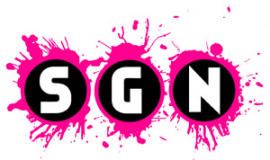 Time Reliance Zapak Games and Jump Games from India take notice of SGN.
Time Reliance Zapak Games and Jump Games from India take notice of SGN.Jeff Bezos backs Social Gaming Network : The Social Gaming Network , a start-up that develops games for social platforms such as Facebook and OpenSocial, has received an undisclosed amount of funding from Amazon.com founder Jeff Bezos' personal investment firm, Bezos Expeditions. This comes just months after the company closed a $15 million Series A from Greylock Partners, the Founders Fund, and others. Founded by the creators of Web 1.0 page creator Freewebs (which now calls itself Webs.com), the Social Gaming Network has assembled a portfolio of popular Facebook applications, such as Jetman, Super Snake, and Free Gifts, some of which it acquired from independent developers. It counts more than 54 million game installs.
SGN is one of the more prominent players in the casual-game space. It competes with Zynga, which was created by Tribe.net founder Mark Pincus.
The aim of the new funding, according to CEO Shervin Pishevar, is "to continue capturing new demographics in gaming by distributing the highest-quality games available on the social Web."
Bezos Expeditions also joined the most recent round of Twitter funding.
Source: http://news.cnet.com/8301-13577_3-9990125-36.html
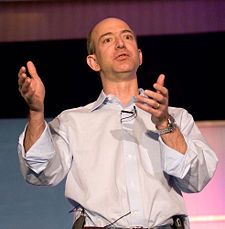
He ranks among the top 15 people who changed the internet .
Source: http://www.yugatech.com/blog/the-internet/top-15-people-who-changed-the-internet/
Jeffrey Preston Bezos had that same experience when he first peered into the maze of connected computers called the World Wide Web and realized that the future of retailing was glowing back at him. It's not that nobody else noticed--eBay's Pierre Omidyar also knew he was on to something. But Bezos' vision of the online retailing universe was so complete, his Amazon.com site so elegant and appealing, that it became from Day One the point of reference for anyone who had anything to sell online. And that, it turns out, is everyone.
Source: http://www.time.com/time/magazine/article/0,9171,992927-2,00.html
India and world food crisis
The Food Corporation of India (FCI), a wing of the public distribution ministry, last year provided almost 38 million tons of subsidized rice and wheat to hundreds of millions of people living below or near India's poverty line of around 30 U.S. cents a day.
The continuing surge in global food prices is throwing India into a vexing dilemma: how to cement its status as a rising economic superpower while providing for its millions of underfed citizens.
Source: http://news.nationalgeographic.com/news/2008/07/080715-india-food.html
Global food crisis comes back to calories . The nutritional results of this crisis are unlikely to be pretty. Already, nearly a billion people in the world do not get enough calories to meet their daily needs. Expect that number to rise. Not enough food means human misery, perhaps on an unprecedented scale.
My advice about healthful eating is simple:
-- Eat less.
-- Move more.
-- Eat plenty of fruits, vegetables and whole grains.
-- Don't eat too much junk food.
Source: http://www.sfgate.com/cgi-bin/article.cgi?f=/c/a/2008/07/15/FD8811AVK1.DTL
Food ‘crisis’ dubbed wake-up call for governments in Asia : When world rice prices hit 1,000 dollars per ton in May, more than doubling over five months, Asian governments were forced to do something they haven’t done for decades: Take a serious look at their neglected agriculture sectors.
Source: http://www.mb.com.ph/BSNS20080716129874.html
As China and India grew more prosperous they began to add to inflationary pressures, rather than subtract from them, by demanding more oil and food and pushing up the global prices of commodities. As the US – which had been growing beyond its means for years – began to adjust, the dollar plummeted on foreign exchanges. That put further upward pressure on prices since a lower dollar means that imports become more expensive
Source: http://www.timesonline.co.uk/tol/comment/columnists/gerard_baker/article4340443.ece
Monday, July 14, 2008
What’s Beyond 3G?
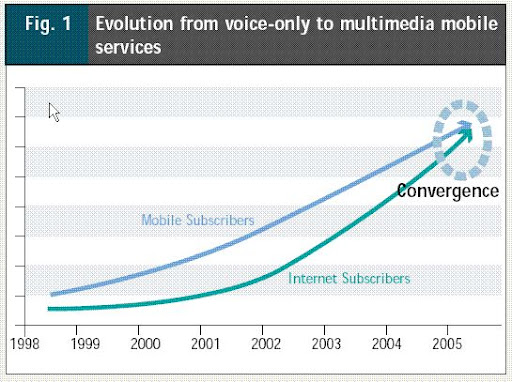 The evolution from voice-only functions to need for users to work with multimedia services have slowly converged. The demand is defined in three stages.
The evolution from voice-only functions to need for users to work with multimedia services have slowly converged. The demand is defined in three stages.a) Network carriers preferences
b) Mobile manufacturer prefer
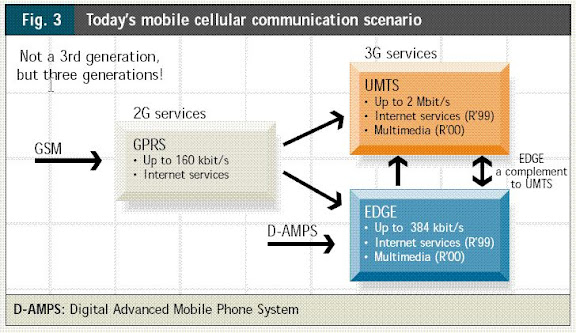 GSM also called 2G is based on time division multiple access evolve dinto GPRS also called 2.5G. It provides moderate speed data transfer, by using unused (TDMA) channels . GPRS can be used for services such as Wireless Application Protocol (WAP) access, Short Message Service (SMS), Multimedia Messaging Service (MMS), and for Internet communication services such as email and World Wide Web access. GPRS data transfer is typically charged per megabyte of traffic transferred, while data communication via traditional circuit switching is billed per minute of connection time, independent of whether the user actually is using the capacity or is in an idle state. GPRS is a best-effort packet switched service, as opposed to circuit switching, where a certain Quality of Service (QoS) is guaranteed during the connection for non-mobile users.
GSM also called 2G is based on time division multiple access evolve dinto GPRS also called 2.5G. It provides moderate speed data transfer, by using unused (TDMA) channels . GPRS can be used for services such as Wireless Application Protocol (WAP) access, Short Message Service (SMS), Multimedia Messaging Service (MMS), and for Internet communication services such as email and World Wide Web access. GPRS data transfer is typically charged per megabyte of traffic transferred, while data communication via traditional circuit switching is billed per minute of connection time, independent of whether the user actually is using the capacity or is in an idle state. GPRS is a best-effort packet switched service, as opposed to circuit switching, where a certain Quality of Service (QoS) is guaranteed during the connection for non-mobile users.Circuit Switched Data (CSD) is the original form of data transmission developed for the time division multiple access (TDMA)-based mobile phone systems like Global System for Mobile Communications (GSM). CSD uses a single radio time slot to deliver 9.6 kbit/s data transmission to the GSM Network and Switching Subsystem where it could be connected through the equivalent of a normal modem to the Public Switched Telephone Network (PSTN) allowing direct calls to any dial-up service.
High-Speed Circuit-Switched Data (HSCSD), is an enhancement to Circuit Switched Data, the original data transmission mechanism of the GSM mobile phone system, four times faster than GSM, with data rates up to 38.4 kbit/s. One innovation in HSCSD is to allow different error correction methods to be used for data transfer. The original error correction used in GSM was designed to work at the limits of coverage and in the worst case that GSM will handle. This means that a large part of the GSM transmission capacity is taken up with error correction codes. HSCSD provides different levels of possible error correction which can be used according to the quality of the radio link. This means that in the best conditions 14.4 kbit/s can be put through a single time slot that under CSD would only carry 9.6 kbit/s, for a 50% improvement in throughput.
HSCSD is also an option in EDGE and UMTS systems where packet data transmission rates are much higher. In the UMTS system the advantages of HSCSD over packet data are even lower since the UMTS radio interface has been specifically designed to support high bandwidth, low latency packet connections. This means that the primary reason to use HSCSD in this environment would be access to legacy dial up systems.
Enhanced Data Rates for GSM Evolution. EDGE is generally classified as 2.75G . EDGE can be used for any packet switched application, such as an Internet connection. High-speed data applications such as video services and other multimedia benefit from EGPRS' increased data capacity. EDGE/EGPRS is implemented as a bolt-on enhancement for 2G and 2.5G GSM and GPRS networks, making it easier for existing GSM carriers to upgrade to it. EDGE/EGPRS is a superset to GPRS and can function on any network with GPRS deployed on it, provided the carrier implements the necessary upgrade. Athough EDGE requires no hardware or software changes to be made in GSM core networks, base stations must be modified. EDGE compatible transceiver units must be installed and the base station subsystem needs to be upgraded to support EDGE. New mobile terminal hardware and software is also required to decode/encode the new modulation and coding schemes and carry the higher user data rates to implement new services.
EDGE Evolution improves on EDGE in a number of ways. Latencies are reduced by lowering the Transmission Time Interval by half (from 20 ms to 10 ms). Bit rates are increased up to 1 MBit/s peak speed and latencies down to 100 ms using dual carriers, higher symbol rate and higher-order modulation (32QAM and 16QAM instead of 8-PSK), and turbo codes to improve error correction. And finally signal quality is improved using dual antennas. An EDGE Evolution terminal or network can support some of these improvements, or roll them out in stages.
EDGE is actively supported by GSM operators in North America. Some GSM operators elsewhere viewed UMTS the ultimate upgrade path and either planned to skip EDGE altogether or use it outside the UMTS coverage area. However, the high cost and slow uptake of UMTS have resulted in fairly common support for EDGE in the global GSM/GPRS market
Alternatively , Code division multiple access (CDMA) is a channel access method utilized by various radio communication technologies
W-CDMA (Wideband Code Division Multiple Access) is a type of 3G cellular network. W-CDMA is the higher speed transmission protocol used in the Japanese FOMA system and in the UMTS system, a third generation follow-on to the 2G GSM networks deployed worldwide.
Universal Mobile Telecommunications System (UMTS) is one of the third-generation (3G) cell phone technologies, which is also being developed into a 4G technology. Currently, the most common form of UMTS uses W-CDMA as the underlying air interface. It is standardized by the 3GPP, and is the European answer to the ITU IMT-2000 requirements for 3G cellular radio systems. To differentiate UMTS from competing network technologies, UMTS is sometimes marketed as 3GSM, emphasizing the combination of the 3G nature of the technology and the GSM standard which it was designed to succeed.
UMTS, using W-CDMA, supports up to 14.0 Mbit/s data transfer rates in theory (with HSDPA), although at the moment users in deployed networks can expect a transfer rate of up to 384 kbit/s for R99 handsets, and 7.2 Mbit/s for HSDPA handsets in the downlink connection. This is still much greater than the 9.6 kbit/s of a single GSM error-corrected circuit switched data channel or multiple 9.6 kbit/s channels in HSCSD (14.4 kbit/s for CDMAOne), and—in competition to other network technologies such as CDMA2000, PHS or WLAN—offers access to the World Wide Web and other data services on mobile devices.
High-Speed Downlink Packet Access (HSDPA) is a 3G (third generation) mobile telephony communications protocol in the High-Speed Packet Access (HSPA) family, which allows networks based on Universal Mobile Telecommunications System (UMTS) to have higher data transfer speeds and capacity. Current HSDPA deployments support down-link speeds of 1.8, 3.6, 7.2 and 14.4 Mbit/s. Further speed increases are available with HSPA+, which provides speeds of up to 42 Mbit/s downlink.
Evolution-Data Optimized or Evolution-Data only, abbreviated as EV-DO or EVDO and often EV, is a telecommunications standard for the wireless transmission of data through radio signals, typically for broadband Internet access. It uses multiplexing techniques including Code division multiple access (CDMA) as well as Time division multiple access (TDMA) to maximize both individual user's throughput and the overall system throughput. It is standardized by 3rd Generation Partnership Project 2 (3GPP2) as part of the CDMA2000 family of standards and has been adopted by many mobile phone service providers around the world – particularly those previously employing CDMA networks. It is also used on the Globalstar satellite phone network.
UMB (Ultra Mobile Broadband) is the brand name for the project within 3GPP2 to improve the CDMA2000 mobile phone standard for next generation applications and requirements. The system is based upon Internet (TCP/IP) networking technologies running over a next generation radio system, with peak rates of up to 280 Mbit/s. Its designers intend for the system to be more efficient and capable of providing more services than the technologies it replaces. Commercialization is unlikely as Qualcomm, its main developer, 3GPP2 and major CDMA carriers are concentrating on LTE instead.
Longer term, the 3GPP Long Term Evolution project plans to move UMTS to 4G speeds of 100 Mbit/s down and 50 Mbit/s up, using a next generation air interface technology based upon OFDM. UMTS supports mobile videoconferencing, although experience in Japan and elsewhere has shown that user demand for video calls is not very high. Other possible uses for UMTS include the downloading of music and video content, as well as live TV.
3GPP LTE (Long Term Evolution) is the name given to a project within the Third Generation Partnership Project to improve the UMTS mobile phone standard to cope with future technology evolutions. Goals include improving spectral efficiency, lowering costs, improving services, making use of new spectrum and refarmed spectrum opportunities, and better integration with other open standards. The LTE project is not a standard, but it will result in the new evolved Release 8 of the 3GPP specifications, including mostly or wholly extensions and modifications of the UMTS system. The architecture that will result from this work is called EPS (Evolved Packet System) and comprises E-UTRAN (Evolved UTRAN) on the access side and EPC (Evolved Packet Core) on the core side.
While 3GPP Release 8 has yet to be ratified as a standard, much of the standard will be oriented around upgrading UMTS to a so-called fourth generation mobile communications technology, essentially a wireless broadband Internet system with voice and other services built on top.
The standard includes:
Peak download rates of 326.4 Mbit/s for 4x4 antennas, 172.8 Mbit/s for 2x2 antennas for every 20 MHz of spectrum. [1] Peak upload rates of 86.4 Mbit/s for every 20 MHz of spectrum.[2] At least 200 active users in every 5 MHz cell. (i.e., 200 active data clients) Sub-5ms latency for small IP packets Increased spectrum flexibility, with spectrum slices as small as 1.4 MHz (and as large as 20 MHz) supported (W-CDMA requires 5 MHz slices, leading to some problems with roll-outs of the technology in countries where 5 MHz is a commonly allocated amount of spectrum, and is frequently already in use with legacy standards such as 2G GSM and cdmaOne.) Limiting sizes to 5 MHz also limited the amount of bandwidth per handset Optimal cell size of 5 km, 30 km sizes with reasonable performance, and up to 100 km cell sizes supported with acceptable performance Co-existence with legacy standards (users can transparently start a call or transfer of data in an area using an LTE standard, and, should coverage be unavailable, continue the operation without any action on their part using GSM/GPRS or W-CDMA-based UMTS or even 3GPP2 networks such as CDMA or EV-DO) A large amount of the work is aimed at simplifying the architecture of the system, as it transits from the existing UMTS circuit + packet switching combined network, to an all-IP flat architecture system.
Preliminary requirements have been released for LTE-Advanced, expected to be part of 3GPP Release 9. LTE-Advanced will be a software upgrade for LTE networks and enable peak download rates over 1Gbit/s. It also targets faster switching between power states and improved performance at the cell edge.
The LTE standard reached the functional freeze milestone in March 2008. Stage 2 Freeze is scheduled for mid 2008 and official ratification in December 2008. The standard has been complete enough that hardware designers have been designing chipsets, test equipment and base stations for some time. LTE test equipment has been shipping from several vendors since early 2008 & Motorola demonstrated a LTE RAN standard compliant eNodeB and LTE chipset at Mobile World Congress 2008.
 Of the 3.4 billion mobile subscribers globally, only 10% or so use a 3G network. With all that room for growth in 3G, why has the industry started talking so much about 4G?
Of the 3.4 billion mobile subscribers globally, only 10% or so use a 3G network. With all that room for growth in 3G, why has the industry started talking so much about 4G?During the Mobile World Congress in Barcelona in February, 4G technologies like Long Term Evolution (LTE) and WiMAX were among the top 10 topics for discussion in conference rooms and hallways.
Speaking at MWC, Carl-Henric Svanberg, president and CEO of Ericsson, highlighted the growth opportunities for W-CDMA and its high-speed packet access (HSPA) upgrade, saying there were 180 million W-CDMA subscribers while the number was growing by 6.5 million a month.
“In 2008, Ericsson expects to see 3G/HSPA networks rolled out in Latin America, Middle East, Africa and Russia, with India coming on board by end of the year,” Svanberg said. “Additionally, we see that in the 3G networks that we monitor in Europe data traffic now exceeds voice and accelerates quickly, from between 50% to 1,500% depending on the operator’s strategy.”
Still, all of the major infrastructure vendors and even some carriers were talking about 4G, and especially LTE. Verizon Wireless announced last fall that it would abandon the CDMA evolutionary path and target LTE for the future. Four more of the world’s largest carriers, Vodafone, China Mobile, NTT DoCoMo and AT&T Mobility, also have said LTE is in their future as well.
THE FACES OF LTEVodafone has a financial interest in both Verizon Wireless and China Mobile and the three carriers plan to test the technology together. China Mobile will be looking at both frequency division and time division flavors of LTE, the latter because it is expected to deploy TD-SCDMA as a 3G technology this year and would like the backward compatibility.
The basic LTE standard was only approved in late January and is still under final review before becoming part of the upcoming 3GPP Release 8 protocols. Like other air interface technologies couched as 4G, LTE uses orthogonal frequency division multiple access (OFMDA), as well as multiple-in, multiple-out (MIMO) antenna strategies.
Most analysts think it will be at least 2010 and more likely 2011 before LTE equipment starts getting deployed. That’s creates a possible opportunity for another technology some call 4G – WiMAX. WiMAX doesn’t yet have the data rates that LTE (10 Mbps vs. 100 Mbps) but still could provide multimedia applications like video.
Analysts have just started making forecasts for 4G uptake, including LTE, WiMAX and 3GPP2’s Ultra-Mobile Broadband (UMB) fostered by the CDMA community. ABI Research is expecting more than 90 million subscribers for LTE and WiMAX in 2013. Another research firm, Analysys, is suggesting the number of LTE subscribers will hit 400 million by 2015.
WiMAX PUSHING LTEWiMAX networks are rolling out globally, mostly by greenfield and fixed-line operators. A notable exception is Sprint’s Xohm deployment, which has been in trials in three cities and is expected to soon launch commercially.
The rollout of WiMAX is one of the big reasons many analysts think the LTE vendors and carriers are being more aggressive with launch plans.
“LTE is being pushed along as a result of WiMAX actually being where it is,” says Godfrey Chua, research manager with the analyst firm IDC. He says WiMAX is not necessarily a competitor to LTE as a technology, but that traditional cellular carriers have not shown much interest in WiMAX and want to have a technology roadmap that matches or surpasses WiMAX.
Of course, the traditional GSM carriers also will have another technology evolution before reaching LTE. That’s HSPA+, the next iteration in the W-CDMA/HSPA technology that expects to provide data rates of about 24Mbps to 40 Mbps. HSPA+, also called HSPA Evolved, is expected to be deployed starting in 2010.
UMB, meanwhile, is either a dead technology or will have only a niche role in the future, depending on who you’re talking with. Chua points out that Pat Russo, Alcatel Lucent’s CEO, showed a slide at MWC that showed the technology path of both CDMA EV-DO and UMTS converging on LTE. “When you have the largest CDMA vendor in the world talking about LTE, it’s indicative of where things stand,” he says.
Allen Nogee, principal analyst for In-Stat on wireless technology and infrastructure, says flatly that “UMB won’t be happening.” He says UMB is a good technology but there are just two few customers available to it now that Verizon Wireless has taken the LTE route.
“UMB requires a large base station change, and if you are going to do that, why not just switch to LTE or WiMAX,” he asks. “Even Qualcomm has made working on the CDMA-to-LTE migration path a priority.
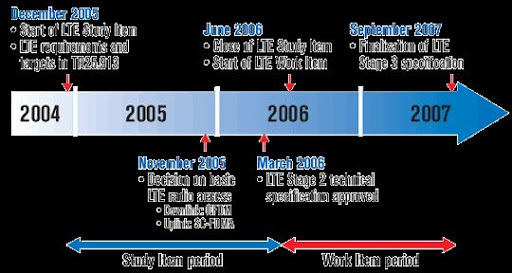 THE MULTIMODAL PLAYIn fact, Qualcomm has joined with Vodafone, Ericsson and Huawei on a forthcoming trial of HSPA+. Vodafone started deploying HSPA last year, with data rates of up to 7.2 Mbps.
THE MULTIMODAL PLAYIn fact, Qualcomm has joined with Vodafone, Ericsson and Huawei on a forthcoming trial of HSPA+. Vodafone started deploying HSPA last year, with data rates of up to 7.2 Mbps.Peter Carson, senior director of product management in Qualcomm’s semiconductor group, says access to all these various air interfaces will be done on the device side through multimodal chips. Qualcomm announced in February it was expanding its device and base station chipsets to include LTE along with UMTS and CDMA2000. Carson says the chipsets will allow backward compatibility to legacy UMTS and CDMA2000 networks for carriers that deploy LTE.
Qualcomm’s multimode LTE chipsets will start sampling next year, assuming the 3GPP finalizes the standard.
Carson says Qualcomm hasn’t given up on UMB because few operators have signed commercial contracts for LTE. Meanwhile, he says, 3G technology improvements are going to improve performance for those technologies, especially where spectrum bands are 5 MHz or less.
“We have EV-DO Rev. B and Release 8 for UMTS under way,” he says. “3G isn’t standing still. The bar continues to get raised by 3G. That makes differentiation a challenge even in OFDMA standards.”
Qualcomm also has no plans to enter the WiMAX market, but Carson says the company is watching how that technology rolls out.
Arun Bhikshesvaran, Ericsson’s chief technology officer and strategy vice president for North America, says the company has demonstrated LTE with data rates up to 160 Mbps in frequency division duplex (FDD) mode and also recently demonstrated LTE using both FDD and time division duplex (TDD) on the same base station. The company also made what it says was the first demonstration of an end-to-end phone call using LTE, with handsets developed by Ericsson Mobile Platforms.
Bhikshesvaran thinks LTE will be rolled out first in Japan and the United States. He notes the United States isn’t playing second fiddle to anyone in wireless technology, being the first in the world with W-CDMA/HSDPA with AT&T’s launch more than a year ago. LTE could even find a home in a network deployed by winners of the FCC’s ongoing 700 MHz spectrum auction.
During MWC, Vodafone CEO Arun Sarin said WiMAX might somehow find a future in the LTE standards. The two are not compatible now, although Danny Locklear, director of wireless product marketing at Nortel, says there are many similarities, especially in the use of OFDM and MIMO.
Locklear: Industrypolitics could preventany LTE/WiMAXcompatibility roadmap.
But Locklear thinks any linkup between LTE and WiMAX may be doomed just because of the politics. The GSM/UMTS community needs backward compatibility with LTE, while WiMAX doesn’t have any backward compatibility. He also notes that most traditional cellular carriers are going to opt for LTE, while WiMAX will provide a differentiated mobile offering for greenfield and fixed-line operators.
“We see Sprint as unique,” Locklear says. “Most existing cellular carriers we believe will move to LTE, which will require some level of backward compatibility.”
Will the 2- or 3-year time-to-market advantage for WiMAX delay the deployment of LTE? Locklear thinks not, just because there is such momentum being generated by carriers like Verizon Wireless, Vodafone, DoCoMo, and AT&T. Ericsson’s Bhikshesvaran agrees.
“The momentum behind LTE is extremely powerful now,” he says. “From the 3GPP track, 3GPP2 track and from China. Some of the largest operators in the world are behind it. They represent a significant chunk of consumers and enterprises on wireless today.”
http://www.wirelessweek.com/Article-What-is-Beyond-3G.aspx
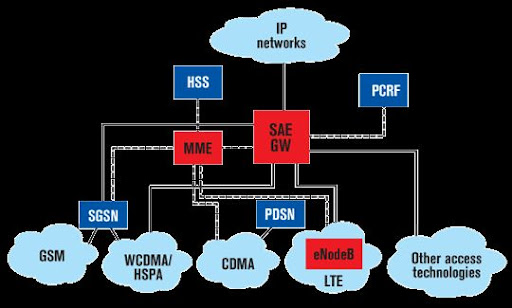
4G?
Orthogonal frequency-division multiplexing (OFDM) — essentially identical to Coded OFDM (COFDM) and Discrete multi-tone modulation (DMT) — is a frequency-division multiplexing (FDM) scheme utilized as a digital multi-carrier modulation method. A large number of closely-spaced orthogonal sub-carriers are used to carry data. The data are divided into several parallel data streams or channels, one for each sub-carrier. Each sub-carrier is modulated with a conventional modulation scheme (such as quadrature amplitude modulation or phase shift keying) at a low symbol rate, maintaining total data rates similar to conventional single-carrier modulation schemes in the same bandwidth.
Evolved UMTS Terrestrial Radio Access (E-UTRA) is the air interface of 3GPP's Long Term Evolution (LTE) upgrade path for mobile networks. E-UTRA is the successor to HSDPA and HSUPA technologies specified in 3GPP releases 5, 6 and 7. Unlike HSPA, LTE's E-UTRA is an entirely new air interface system, unrelated to and incompatible with W-CDMA.
E-UTRA has the following features:Flexible bandwidth usage with 1.25 MHz to 20 MHz bandwidths. By comparison, W-CDMA uses fixed size 5 MHz chunks of spectrum. Increased spectral efficiency at 2-4 times more than in 3GPP release 6 Peak download rates of 326.4 Mbit/s for 4x4 antennas, 172.8 Mbit/s for 2x2 antennas for every 20 MHz of spectrum. [1] Peak upload rates of 86.4 Mbit/s for every 20 MHz of spectrum.[2] Sub-5ms latency for small IP packets.
E-UTRA was designed to achieve the goals set by the 3GPP LTE project. The improvements in performance allow wireless operators to offer 'quadruple play' services - voice, high-speed interactive applications including large data transfer and feature-rich IPTV with full mobility.
Although UMTS, with HSDPA and HSUPA, delivers high data transfer rates, wireless data usage is expected to increase significantly over the next few years. The emergence of competitive technologies, such as WiMAX, is driving operators to upgrade their networks to support better data rates. E-UTRA also dramatically improves the capacity of the network.
As a part of 3GPP Release 8, E-UTRA is designed to provide a single evolution path for both UMTS and EV-DO service providers, providing increases in data speeds, and spectral efficiency, and allowing the provision of more functionality
WiMAX, the Worldwide Interoperability for Microwave Access, is a telecommunications technology that provides wireless data in a variety of ways, from point-to-point links to full mobile cellular type access. It is based on the IEEE 802.16 standard, which is also called WirelessMAN. The name "WiMAX" was created by the WiMAX Forum, which was formed in June 2001 to promote conformance and interoperability of the standard. The forum describes WiMAX as "a standards-based technology enabling the delivery of last mile wireless broadband access as an alternative to cable and DSL" (and also to High Speed Packet Access).[citation needed]
Currently, Pakistan has the largest fully functional Wimax network in the world. Wateen Telecom installed the network (with an initial rollout in seventeen cities) throughout Pakistan using Motorola hardware. The wireless industry, although perpetually evolving, is currentlyin an unprecedented state of transition. The emerging 4G airinterfaces, including WiMAX, LTE, UMB, 802.20, WiBro and next-generationPHS and the like, all share certain common features: all arebased on Orthogonal Frequency Division Multiple Access (OFDMA);all exploit Multiple Input Multiple Output (MIMO); and all have “flattenedarchitecture” and are based on Internet Protocol.
Version Released Info
Release 98 1998 This and earlier releases specify pre-3G GSM networks
Release 99 2000 Q1 Specified the first UMTS 3G networks, incorporating a CDMA air interface
Release 4 2001 Q2 Originally called the Release 2000 - added features including an all-IP Core Network
Release 5 2002 Q1 Introduced IMS and HSDPA
Release 6 2004 Q4 Integrated operation with Wireless LAN networks and adds HSUPA, MBMS, enhancements to IMS such as Push to Talk over Cellular (PoC), GAN
Release 7 2007 Q4 Focuses on decreasing latency, improvements to QoS and real-time applications such as VoIP. This specification will also focus on HSPA+ (High Speed Packet Access Evolution), SIM high-speed protocol and contactless front-end interface (Near Field Communication enabling operators to deliver contactless services like Mobile Payments), EDGE Evolution.
Release 8 and onwards In progress (expected 2009) LTE, All-IP Network (SAE). Release 8 constitutes a refactoring of UMTS as an entirely IP based fourth-generation network.

Shows the evolution from 1G to 3G

Need for wimax and MIMo application

Residential use of applicances with LTE

Future multi generation 2g, 3G backward compatibility network along with IP packet based and wimax needs

User speed wlong with UTMS and Wimax convergence
Bharti Airtel and Apple to Bring iPhone 3G to India
NEW DELHI and SAN FRANCISCO—June 10, 2008—Bharti Airtel and Apple® today announced that they will be bringing the highly anticipated iPhone™ 3G to customers in India later this year. iPhone 3G combines all the revolutionary features of iPhone with 3G networking that is twice as fast* as the first generation iPhone, built-in GPS for expanded location based mobile services, and iPhone 2.0 software which includes support for Microsoft Exchange ActiveSync and runs the hundreds of third party applications already built with the recently released iPhone SDK. “We are delighted with the opportunity to bring the innovative iPhone 3G to India,” said Manoj Kohli, President and CEO, Bharti Airtel. “As India’s leading telecom operator, Bharti Airtel has always stood for innovation and customer delight. With our reach across the country and iphone’s revolutionary features, we have a valuable proposition for our customers in India.” “We are thrilled to be working with Bharti Airtel, India’s leading integrated telecom company, to bring iPhone 3G to millions of mobile customers in India,” said Tim Cook, Apple’s COO. “We can’t wait to get this revolutionary product in the hands of even more people around the world.” Soon customers will be able to purchase iPhone 3G at Airtel Relationship Centers. Details of pricing and availability will be announced at a later date. Airtel Customers who wish to receive more information on iPhone can send an SMS with keyword 'iPhone' to 54321 ( tollfree). *Based on 3G and EDGE testing. Actual speeds vary by site conditions.



